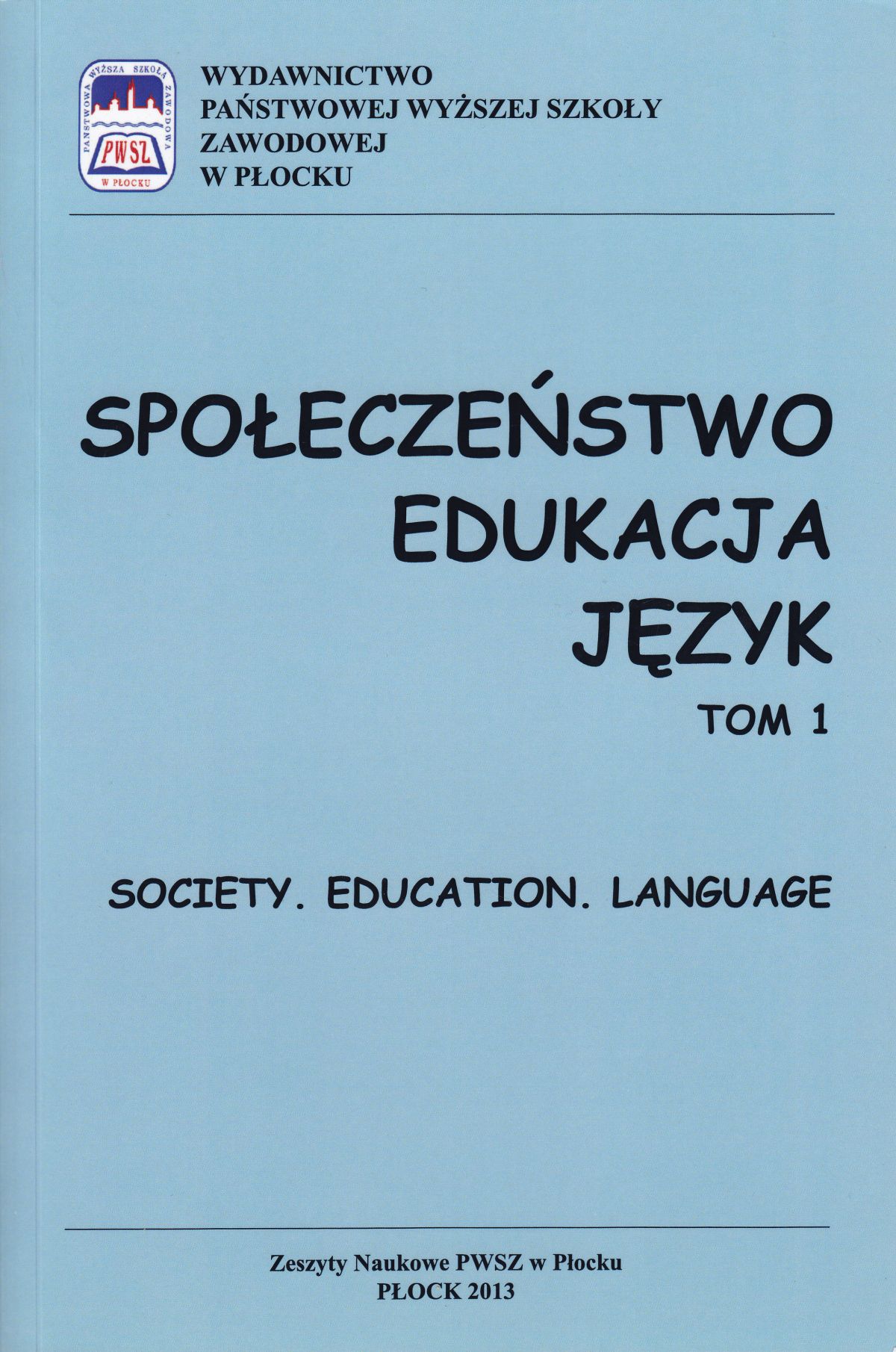NABYWANIE KOMPETENCJI EMOCJONALNEJ W KONTAKCIE JĘZYKOWYM
Abstract
Streszczenie
Artykuł przedstawia rozważania nad problematyką miejsca uczuć i emocji w kompetencji
ludzkiej1, szczególnie w odniesieniu do kontekstu kontaktu językowego,
zarówno naturalistycznego (bilingwalizm), jak również w procesie nauczania
i nabywania języka obcego w klasie. Kwestią do oświetlenia pozostaje miejsce
i funkcja emocji w kulturze oraz możliwości rozbudzania świadomości emocjonalnej
ucznia w kontekście dydaktycznym oraz stopnia przyswajania pojęć języka
drugiego (obcego), wyrażających uczucia i emocje. Zaprezentowana jest funkcja
zastosowania technik nauczania, także wywodzących się z językoznawstwa korpusowego,
do podnoszenia emocjonalnej samoświadomości ucznia.
References
Bibliografia
Bamberg, Michael. 1997. “Language, Concepts, and Emotions: The Role of Language
in the Construction of Emotions”. Language Sciences 19(4). 335-342.
Caldwell-Harris, Catherine L., Staroselsky, Marianna, Smashnaya, Svetlana & Nadia
Vasilyeva. 2012. “Emotional Resonances of Bilinguals’ Two Languages Vary with
Age of Arrival: The Russian-English Bilingual Experience in the US”. In Dynamicity
in Emotion Concepts. Łódź Studies in Language, P. A. Wilson (ed.), 373-395. Volume
Frankfurt a. Main: Peter Lang.
Dziwirek, Katarzyna & Barbara Lewandowska-Tomaszczyk. 2010. Complex
Emotions and Grammatical Mismatches. Berlin: Mouton de Gryuter.
Gardner, Howard. 1983. Frames of Mind: The Theory of Multiple Intelligences. New
York: Basic Books.
Harré, Rom (1986) „An outline of the social constructionist viewpoint”. In R. Harré
(Ed.), The Social Construction of Emotions. Oxford, England: Basil Blackwell.
Lakoff, George & Mark Johnson. 1980. Metaphors We Live By. Chicago: Chicago
University Press.
Lewandowska-Tomaszczyk, Barbara. 2012. “Explicit and Tacit – An Interplay of the
Qualitative and Quantitative Approaches to Translation”. In Quantitative Methods in
Corpus-Based Translation Studies, Michael Oakes & Meng Ji (eds.), 3-33. Amsterdam:
Benjamins.
Lewandowska-Tomaszczyk, Barbara. 2012a. Emotional competence, FLT and corpus
materials TALK 2010 - wykład plenarny, Uniwersytet Warszawski.
Lewandowska-Tomaszczyk, Barbara. 2011. “Transcultural Patterns in Communication”.
In Interdisciplinary Approaches to Communication Studies, Adam Bednarek
& Iwona Witczak-Plisiecka (eds.), 7-22. Lodz: Wyższa Szkoła Studiów Międzynarodowych.
Lewandowska-Tomaszczyk, Barbara. (2010). “Re-conceptualization and the Emergence
of Discourse Meaning as a Theory of Translation”. In Meaning in Translation,
Barbara Lewandowska-Tomaszczyk & Marcel Thelen (eds.), 105-148. Frankfurt a.
Main: Peter Lang.
Lewandowska-Tomaszczyk. 2014. “Emotional awareness and the Noticing Hypothesis”.
W: Szubko-Sitarek, Weronika, Lukasz Salski, and Piotr Stalmaszczyk Language
Learning, Discourse and Communication [Second Language Learning and
Teaching]. Switzerland: Springer International Publishing. 215-227.
Lewandowska-Tomaszczyk, Barbara & Paul Wilson. 2013. “English ‘Fear’ and Polish
‘Strach’ in Contrast: GRID Approach and Cognitive Corpus Linguistic Methodology”.
In Components of Emotional Meaning: A Sourcebook, Johnny Fontaine, Klaus
Scherer & Cristinia Soriano (eds.). Oxford: OUP. 425-436.
Ozcelik, Hakan & Zita Zoltay Paprika. 2010. “Developing Emotional Awareness in
Cross-Cultural Communication: A Videoconferencing Approach”. Journal of Management
Education October vol. 34(5): 671-699.
Paradis, Michel. 1994. “Neurolinguistic Aspects of Implicit and Explicit Memory:
Implications for Bilingualism and SLA”. In Implicit and explicit learning of languages,
Nick Ellis (ed.), 393-419. New York: Academic Press.
Społeczeństwo. Edukacja. Język TOM 1
Pavlenko, Aneta. 2008. “Emotion and Emotion-laden Words in the Bilingual Lexicon”.
Language and Cognition 11 (2): 147–164. Cambridge University Press.
Available at: http://journals.cambridge.org
Accessed on: 28 Apr 2009 IP address: 193.61.20.66.
Pavlenko, Aneta. 2004. “’Stop Doing That, ia komu skazala!’: Language Choice and
Emotions in Parent-Child Communication”. Journal of Multilingual and Multicultural
Development, 25 (2/3): 179–203.
Perunovic, W. Q. Elaine & Mihailo Perunovic. 2012. “Language and Emotion: The
Case of Bicultural”. In Dynamicity in Emotion Concepts. [Lodz Studies in Language
vol. 25], P. A. Wilson (ed.), 359-372. Frankfurt a. Main: Peter Lang.
Schmidt, Richard. 1990. “The Role of Consciousness in Second Language Learning”.
Applied Linguistics, 11, 129-158.
Schmidt, Richard. 2010. “Attention, awareness, and individual differences in language
learning”. In: W. M. Chan, S. Chi, K. N. Cin, J. Istanto, M. Nagami, J. W. Sew,
T. Suthiwan, & I. Walker (eds.), Proceedings of CLaSIC 2010, Singapore, December
-4. Singapore: National University of Singapore, Centre for Language Studies. 721-
Whorf, Benjamin Lee. 1956. Language, Thought, and Reality: Selected Writings of
Benjamin Lee
Whorf. (ed. John B. Carroll). Cambridge, Mass.: Technology Press of Massachusetts
Institute of Technology.
Wierzbicka, Anna. 2004. “Preface: ‘Bilingual lives, bilingual experience’”. Special
issue of the Journal of Multilingual and Multicultural Development, 25 (2/3): 94–104.
Wilson, Paul (ed.) 2012. Dynamicity of Emotion Concepts. [Lodz Studies in Language
vol. 25] Frankfurt a. Main: Peter Lang.
Wilson, Paul & Barbara Lewandowska-Tomaszczyk. 2012. “The Nature of
Emotions”. In Dynamicity in Emotion Concepts. [Lodz Studies in Language vol. 25],
-36. Frankfurt a. Main: Peter Lang.
Wilson, Paul & Barbara Lewandowska-Tomaszczyk. 2012a.. “Emotion, approach-
-avoidance motovation, and blending in the evolution of language”. In: Scott-Phillips,
Thomas C., Mόnica Tamariz, Erica A. Cartmill and James R. Hurtford (eds.)
The Evolution of Language Proceedings of the 9th International Conference (EVOLANG9),
Kyoto, Japan, New Jersey: World Scientific. 567-568.
